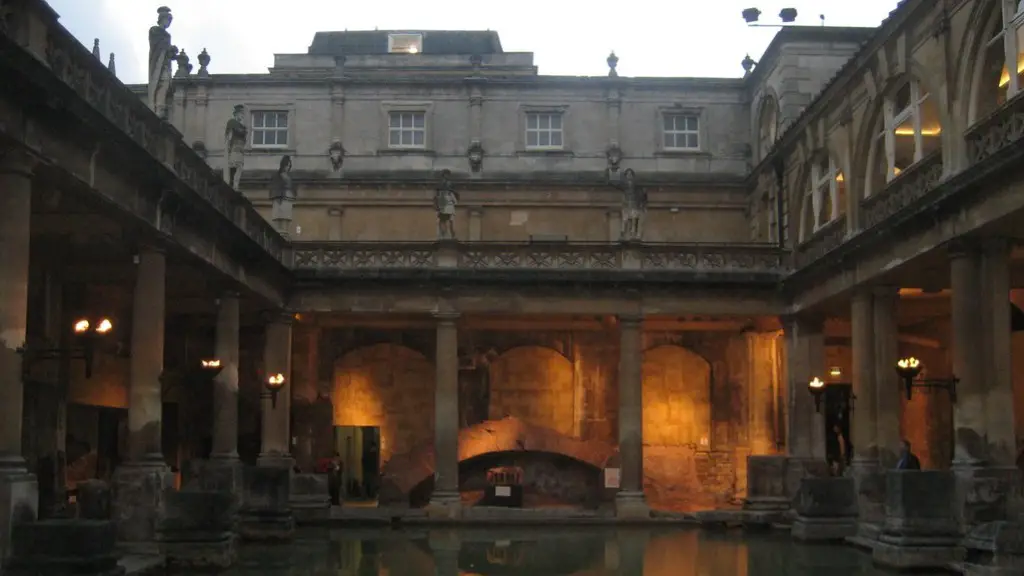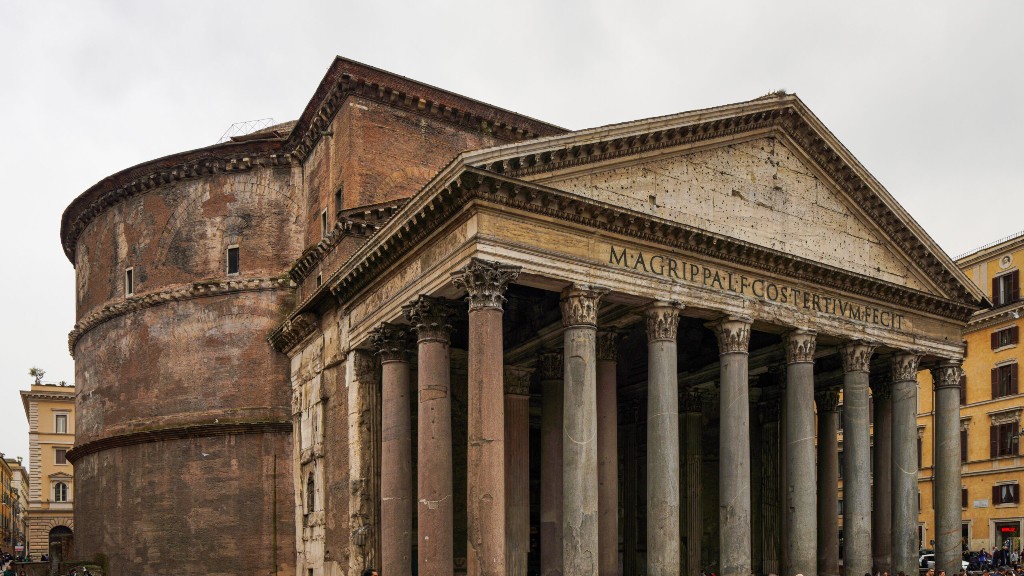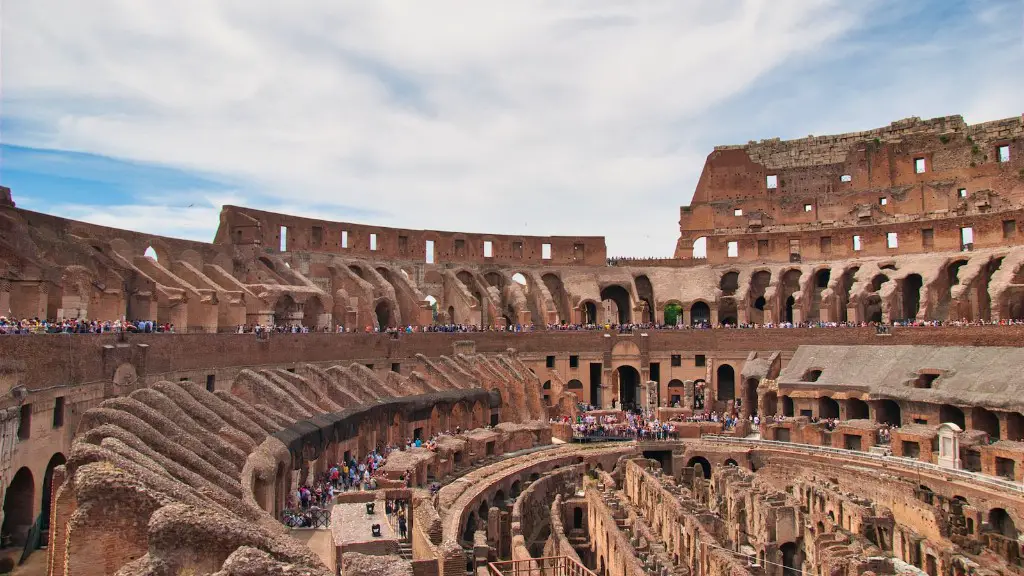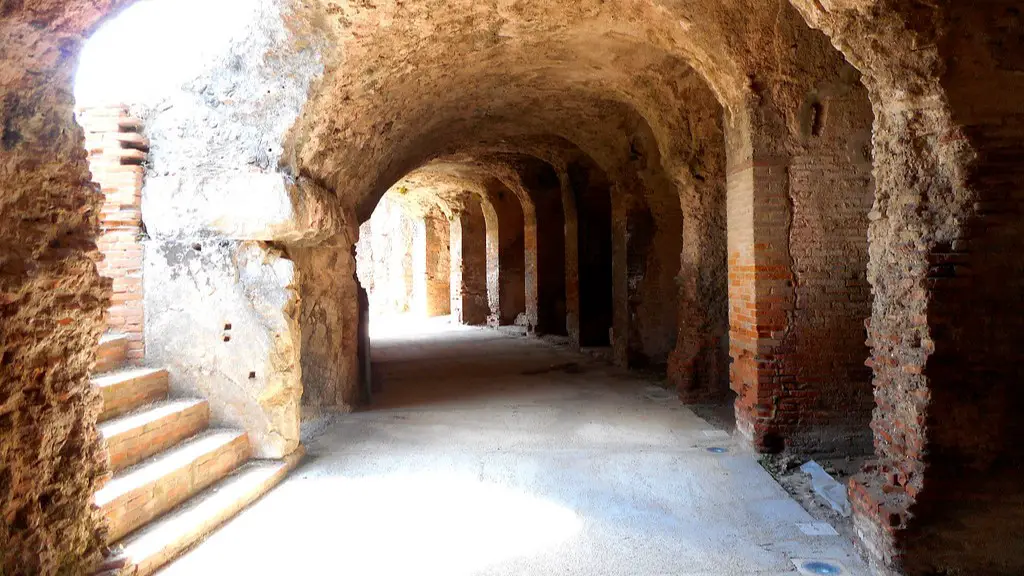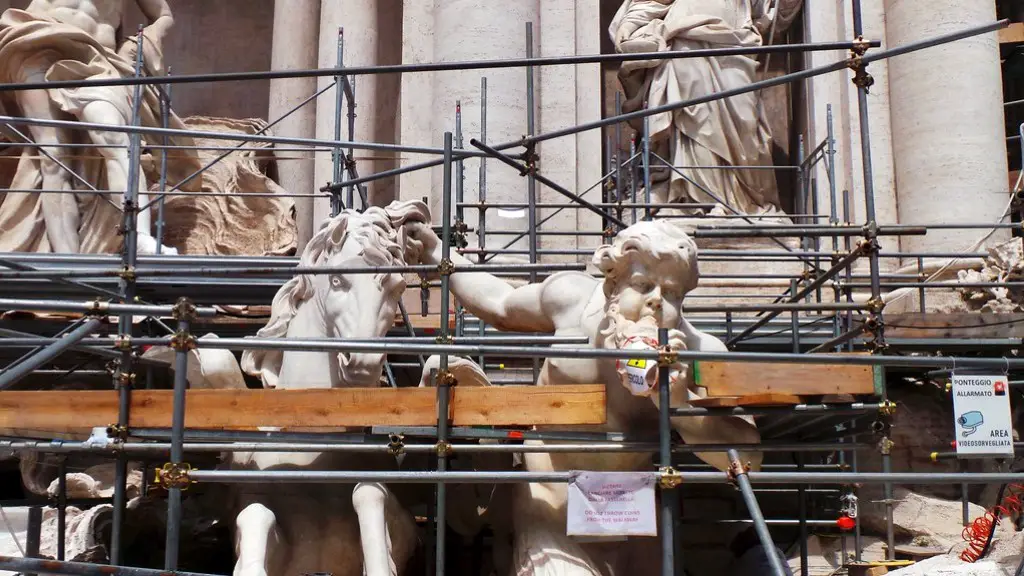Before discussing where the ancient Romans practiced their religion, it is important to have a clear understanding of what exactly the religion of ancient Rome entailed. To begin with, the religion of ancient Rome was formed in the wake of numerous other religions and was influenced by the Greeks. Its main focus was on gods, or the numina (spirits of the forces of nature). These gods were aspects of the universe that included the sun, moon, and stars, as well as concepts like fertility and agriculture. Ancient Romans believed in veneration, rituals, and sacrifices to these gods, in hopes of gaining their favor and protection.
The primary place of practice for the religion of ancient Rome was the home of the gods – the temple. Temples were physical manifestations of the gods’ power and presence. Many temples were dedicated to a specific god, such as Jupiter Optimus Maximus, and others to a group of gods. Each temple had a statue of the god in question, as well as a shrine where offerings and prayers were made.
However, the practice of the religion was not limited to the temple. In fact, many other locations had great religious significance for the ancient Romans. Sacrifices were often made on the Capitoline Hill to ensure success in wars, and the Forum Romanum was a central location for gatherings and rituals. Additionally, more private ceremonies that required special offerings might be held at a family’s home.
The ancient Romans also practiced their faith in the countryside, where certain festivals were held in honor of gods and goddesses. During these festivals, humans and animals were sacrificed in order to appease the gods and bring them luck, fertility, and good harvests. Other local festivals were held in order to honor other deities, such as household gods, or in order to celebrate a particular event or holiday.
In addition to the aforementioned ceremonies, there were also numerous informal religious practices that were observed throughout Rome. Such practices included the erection of small shrines, the offering of wine to the gods, and the holding of special ceremonies whenever an individual faced an important event. These rituals may not have been as strictly structured as those held at temples, but they were still an important part of the religious life for the ancient Romans.
Ceremonies of the Ancient Romans
The ancient Romans observed a wide variety of ceremonies. These included grand processions with dressed-up animals, annual oaths to the gods, and solemn banquets held in honor of various deities. Many of these ceremonies were held in temples, but some were even held in open public areas. One of the most significant ceremonies was the Triumph, which was a public celebration in honor of a victorious military campaign. Other ceremonies that were held in public included funerals, marriages, and religious festivals.
The most important priest of Rome was the Pontifex Maximus. He was responsible for the religious organization and operations of the Roman state. This included keeping track of the Roman calendar, which was based on the phases of the moon, and overseeing a wide range of rituals and ceremonies.
In addition to priests and the Pontifex Maximus, the ancient Roman religion also included various other religious figures. For example, augurs were soothsayers who would attempt to interpret signs from the gods, and seers would look at the entrails of animals to determine what the gods had in store for their followers. Additionally, diviners and astrologers were consulted for their advice and insights.
Influence of Roman Religion
The religion of the ancient Romans had a lasting influence on the development of Christianity. Many of the gods and goddesses of the Roman religion were borrowed from the Greeks, and ultimately their stories were adapted and re-written to fit the Christian narrative. In addition, some of the ceremonies and rituals of the Roman religion, such as the offering of sacrifices, were adapted and incorporated into the Christian faith.
Aside from its influence on Christianity, the religion of the ancient Romans also had a major impact on the development of Roman culture. The gods were a major part of everyday life and were constantly invoked in decisions, conversations, and legal disputes. Roman religion was fundamental to the ideals that Rome was built upon, such as patriotism and loyalty.
In more recent times, the religion of the ancient Romans is still observed in some areas of modern society. For instance, most of the principles of the Roman religion have been adopted into the British system of common law. Additionally, aspects of Roman religion can still be seen in religious festivals, such as the Saturnalia, and public ceremonies, such as the Speaking of the Will at funerals.
Public and Private Aspects of the Religion
Many ancient Roman religious practices could be observed in public and private settings. Public rituals often took place in important civic locations, such as the Forum Romanum, and in the temples of the gods. These ceremonies often revolved around the offering of sacrifices to the gods, as well as the sharing of meals and the performance of prayers.
In contrast, private celebratory rituals and offerings could be conducted in the home. These ceremonies typically had more personal and intimate meanings, often revolving around family matters, such as births and marriages. Additionally, private offerings could be made on an individual basis in hopes of obtaining the favor of a particular god.
Outside of religious ceremonies, the ancient Romans also respected and revered their gods in more subtle ways, such as through art, literature, and daily conversation. This widespread respect and acknowledgement of the gods was essential in maintaining a functioning Roman society, and enduring legacy of the religion lives on even to this day.
Influence on Arts, Literature, and Education
The religion of the ancient Romans was integral to the development of art, literature, and education in the ancient world. Artists of the era were heavily influenced by the gods and goddesses of the religion, often portraying them in their works of art. Likewise, literature of the time also had a heavy religious influence, with authors often drawing on the gods and goddesses for inspiration.
Finally, the religion of the ancient Romans was central to the education system of the time. In addition to the study of the ancient philosophers, students would also be educated in the beliefs, customs, and rituals of the religion. This was done in order to instill in students a sense of civic duty, as well as to demonstrate the importance of the gods in Roman life and culture.
Overall, the religion of the ancient Romans had an incredibly lasting influence on the world. From the artistic works of the era to the principles of common law, the religion of ancient Rome is still observed in many facets of modern society. It’s impressive to see just how many of its aspects have endured over millennia, and it serves to show the incredible power of faith.
Evolution of the Religion
Despite its importance to the Roman Empire, the religion of the ancient Romans went through a rapid period of change, particularly during the period of the Republic. This period saw a large number of changes to the pantheon of gods, as well as an adoption of many of the practices and beliefs of neighbouring cultures. Additionally, Rome would also adopt numerous finer details from even farther afield, including from the Celts and Scythians.
During the period of the Empire, the Roman religion underwent another major period of change. Emperor Augustus stripped away some of the more extreme rituals, such as the offering of human sacrifices, and elevated the role of the Pontifex Maximus to oversee state religion. Additionally, there was a resurgence in the popularity of the worship of the original gods of the Roman pantheon.
After the fall of the Empire, the religion of the ancient Romans continued to evolve and adapt. Buddhism and other Eastern religions had a major influence on Roman religion during this time, as did Christianity, which ultimately became the dominant faith of the Roman Empire. Despite this, the religion of ancient Rome still has echoes in the beliefs and practices of modern society.
Interaction of Roman Religion with Others
As Rome grew and expanded, the religion of the ancient Romans interacted with and influenced the religions of neighbouring empires. Religion was seen as a tool to spread Roman power and influence, and as such, customs and beliefs from other cultures were slowly adopted into the Roman religion. This was particularly prominent during the period of the Republic, when Rome was actively conquering and expanding its boundaries.
Perhaps most prominent amongst these influences was the religion of the Greeks. As previously mentioned, many of the gods and goddesses of the Romans were based on the gods and goddesses of Greek mythology. Additionally, aspects of the Greek belief system, such as the Olympian gods, were adopted in the later phases of the Roman religion.
The religion of the Etruscans was another major influence on the Romans, particularly during the early period of the Republic. The beliefs and customs of the Etruscans, which were closely intertwined with the religion of the ancient Greeks, were adopted and adapted in order to create the religion of the ancient Romans. This influence was particularly evident in the pantheon of gods, with many of the major gods being based on the gods of the Etruscans.
In addition to the Greeks and Etruscans, the religion of the ancient Romans also interacted with the religions of numerous other cultures, including those of North Africa, India, and the Middle East, as well as those of the Celts, Scythians, and Germans. The legacy of this interaction can still be seen in many of the beliefs and customs of modern religion.
